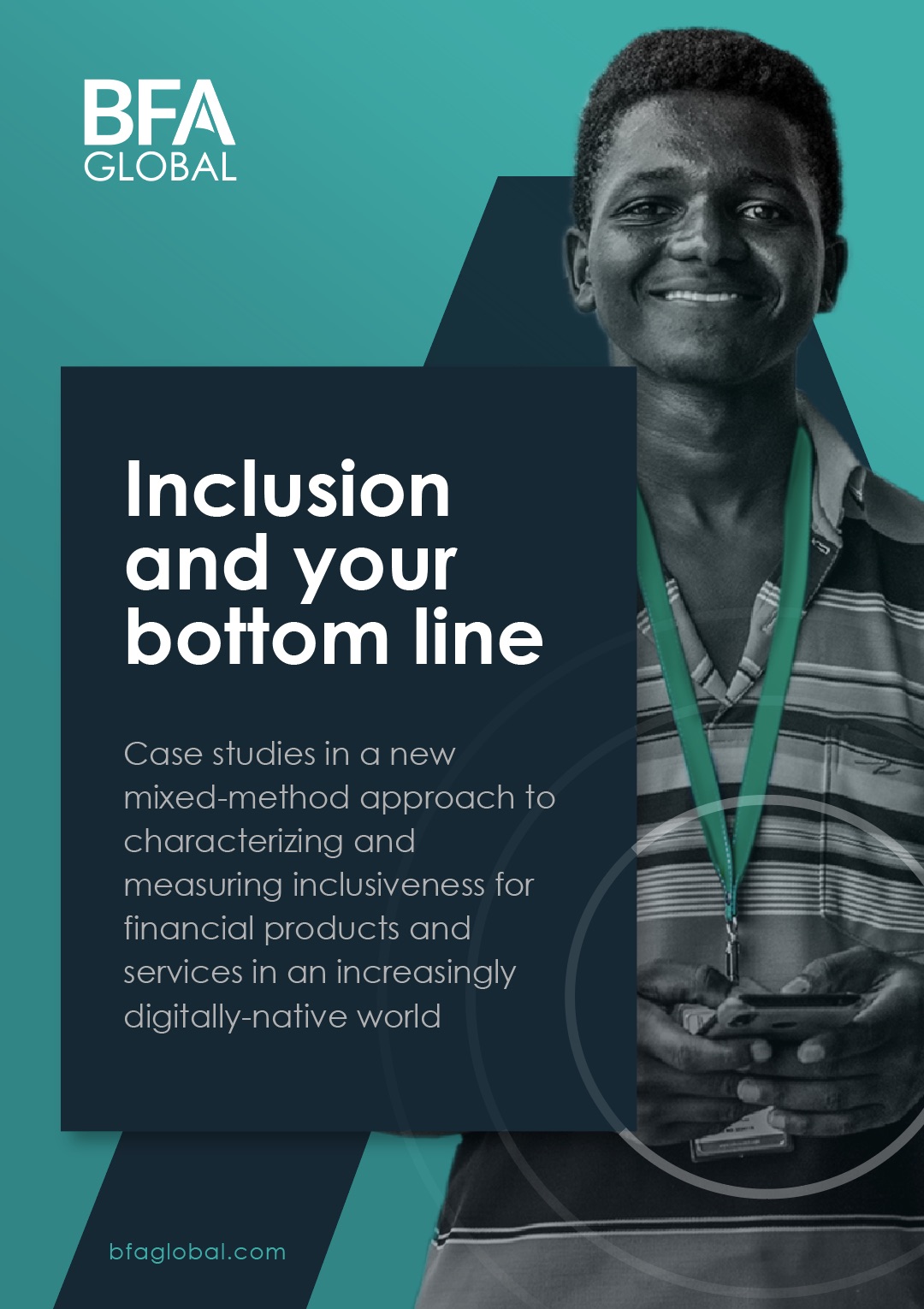How can banks identify and quantitatively validate principal components of inclusiveness and determine which matter most within a given market?

This is the first case study in our report, ‘Inclusion and Your Bottom Line’, which outlines a new mixed-method approach to characterizing and measuring inclusiveness for financial products and services.
Five high-level traits of transaction accounts can unlock strategic insights, and they can be measured using nothing more than customer opinion surveys. Our research has revealed the dimensions of banks’ offerings in emerging markets that matter most to customers: accessibility, coverage, robustness, security, and value.
As noted in our methodology below, it bears mention that the above traits are only what falls out of survey data; so in other related case studies, coverage is subsumed into accessibility, and robustness and security are combined into a larger trait, reliability. Those changes do not reflect the statistical finding from this survey, but rather a composite that emerged from blended research methods after the fact.
The rest of this chapter will explain what the above concepts are, how to measure them, and why it matters.
Banks compete for customers on many criteria at the same time. They must make tradeoffs between offering more access points, better customer service, and competitively priced offerings, in order to remain competitive. A coherent strategy requires situational awareness of the bank’s competitive position in these domains.
Through recent surveys the BFA Global team conducted in three African markets, we saw that a single, standardized survey of customer opinions can produce insights into the competitive position of transaction accounts offered by banks and nonbank financial institutions. Here, we present findings from a customer survey in Nigeria, which identified five traits that matter to customers: accessibility, robustness, security, coverage, and customer service. These traits not only describe how customers evaluate particular transaction accounts, but can also structure financial institutions’ thinking about their service offerings. From the customer survey data we gathered, we produced a set of scores for each bank based directly on the opinions of customers. Armed with effective metrics, banks can optimize their strategy for marketing, product design, and operations.
Crafting the ideal customer survey
The survey that we used strikes a balance between brevity and specificity. The lean data movement cautions us against gathering too much data without a clear plan for actionable learning. In other words, if we don’t know what we should do with the data we gather, then the effort of collecting it is wasted. Taken to a logical extreme, this movement results in single-question surveys such as the Net Promoter Score, which gather information on only a single topic: how costly will it be to acquire the next customer? We can do better than this for retail financial services. The intent of our survey was to understand whether our expert analysis of the key traits of financial products matches those identified from the consumer’s perspective.
Our survey on the key traits of transaction accounts is 29 questions in length, all of which are phrased in plain language. Most of the questions request opinions on a five-point scale, from “Strongly agree” to “Strongly disagree.”
We aggregated these 29 questions into traits using a class of models common in psychometrics, known as “factor analysis.” These models are estimated in a two-phase process, first to identify the traits that matter to consumers from the correlation of responses in the survey data, and second to estimate the contribution of each survey question to those high-level traits. The first phase is called exploratory factor analysis, and the second phase is called confirmatory factor analysis. At a conceptual level, these models assume that responses to individual questions are driven to some extent by a hidden variable, and then measure the correlation of observed responses with the unobserved traits.
At the outset of the project, beginning with desk research, we organized our questionnaire into subsets of questions that were designed to measure the high-level traits using a hypothetical typology of bank traits. Through factor analysis, we were able to identify five common traits that customers use to describe their transaction accounts.
It bears mentioning that the five traits we landed on are not absolute and immutable. The traits identified in Kenya and South Africa differed slightly from what is presented here. These differences are partially due to nuances of survey design, and partially due to intrinsic differences in transactional accounts in these markets.
Seeing the 5 key traits from the customer’s perspective
The five traits that arose from the Nigeria factor analysis were (in no particular order) accessibility, coverage, robustness, security, and value. Exploratory factor analysis confirmed that the optimal number of traits needed to explain Nigerian customers’ views of their banks was five, and confirmed how the questions should be organized into groups to produce the most coherent preferences among customers’ survey data. Confirmatory factor analysis estimated the weight of each question related to a trait in determining the bank’s score for that trait. Then, using original survey data, each bank was given a score in each of these dimensions, estimated from those derived weights and survey responses given by that bank’s customers.
Accessibility
Accessibility refers to the ease of registering for and using the product. For the most savvy customers, accessibility will likely not be the most important trait of a financial product. Yet respondents view “ease of use” as generally correlated in several contexts. Banks that score well on one of these questions are likely to score well on the others. These three questions define accessibility:
- Payments require few steps to complete
- Registration requires little documentation
- Learning to use the account requires little time
The correlation of these three questions into a single dimension was close to what we expected at the outset of the project, with one exception. Catering to low-literacy customers seldom correlated with the ease of registering for an account and learning to use it. This finding, that ease of use for low-literacy customers was uncorrelated with accessibility, may have resulted from our sampling, which required that respondents had completed at least one digital transaction in the past three months. In other words, with a broader sample we could have found that perceptions about accessibility also encompassed literacy-related concerns.
Coverage
Customers in Nigeria saw three distinct components where our experts had hypothesized one, tentatively termed reliability. The survey results illustrate aspects of the concept of reliability as the customer understood them. The first of these, coverage, relates to the availability of funds across time and place. A bank product has good coverage if it can be used anywhere, anytime, and crucially, if it is accepted by most counterparties. This type of network effect has been pivotal to the success of mobile money systems and payment cards. In other words, an account is reliable only if the money can be used when and where it is needed.
Robustness
The second component of reliability emerged as robustness. Customers in Nigeria differentiated banks on the success with which transactions were executed. Some banks performed better than others on three criteria: downtime, clearing time, and failure rates of individual transactions. This dimension relates to the success of the network in processing transactions promptly and successfully. But there is another dimension to reliability, which is oftentimes more important to low-income customers.
Security
The third component of reliability emerged as security. This aspect encompasses all sorts of risks to customers’ balances entrusted to the bank. Customers tend to see the risk of loss as correlated regardless of the cause. Banks that are most vulnerable to fraud are considered untrustworthy. Yet those who charge hidden fees to customers are tarred with the same brush. A bank with poor transparency creates the same customer experience of unexpected loss as a fraudulent access to the account. In other words, the customer views unexpected fees as a security risk, not functionally different from a hacker or a thief.
Value
The fifth component of the factor analysis was value. This component addresses customer service. The main determinants of this factor are the bank’s commitment to resolve concerns easily, promptly, and to the customer’s satisfaction. Yet it also includes questions about value for money and what the customer would be willing to pay for comparable services. The customer’s trust in the bank appears in this dimension as well. From this, we understand that trust in a bank is something more than just the security concern above. Customers want a bank that has their interests at heart, and which will guide them in selecting the financial products that will best suit their needs.
Finally, the customer’s assessment of whether the product promotes financial health — through budgeting, saving, and managing shocks — is also a driver of value. Financial health is a core research interest for BFA Global. It is a touchstone for our thinking about consumer and microenterprise experiences of the Covid-19 pandemic; a purpose for our work on stress testing of financial cooperatives; a focus of our survey of shopkeepers in Mexico; and a driver of the economic prospects for recovery from Covid-19 in Kenya and elsewhere.
We are keenly interested to learn how consumers understand the role of financial health in choosing financial products and user experience. Through this research, we have been able to show that from the customer’s point of view, a product that enhances financial health is a driver of value for money, just the same as a commitment to exceptional customer service or affordable pricing.
Conclusions and insights
For reasons that are somewhat technical in nature, comparisons within a country are more informative than comparisons across countries. This has partly to do with the iterative learning process of the research team in fielding survey research. It may also have to do with systematic differences in the populations recruited to take the survey or the details of survey implementation across countries. Nonetheless, we have also fitted confirmatory factor analysis across countries, in order to focus on the experience of women and the differences between urban and rural settings.
Gender differences in perceived value
Our research revealed that transaction accounts in Nigeria are having more difficulty meeting women’s expectations than men’s, particularly regarding the value trait. The value trait encompasses whether customers believe that the bank will address their concerns. It speaks to whether the bank’s services are effective in helping customers to manage income and expenses. And crucially, it has to do with the customer’s trust in the bank. Women in our Nigerian study consistently rated their banks worse in this dimension than did men. Women also rated their banks lower for coverage — meaning that they could use their accounts where and when they needed them — and security, but the differences were not statistically significant. The five traits identified in our research clarify how banks are failing to meet women’s expectations, and what they can do about it.
Differences in perceptions for urban vs rural customers
Our study also points to some of the drivers of difference between urban and rural areas of Nigeria, but it was not designed to optimize statistical inference for the rural sector. Because the study is underpowered for urban-rural comparisons, the clear patterns of difference apparent in the plots below should be interpreted with caution, pending further research. The statistically significant result in the plot below is actually that peri-urban populations are more likely to be content with the robustness of their accounts. They are more confident that networks and transactions will succeed, as compared to urban and rural populations.
Yet, intuitively, it is concerning to see such low opinions about coverage and security among rural respondents. Rural populations are, potentially, less likely to report that they can use their accounts when needed. They are also less likely to have confidence that their accounts are safe from fraud and hidden fees. Because the respondents in this sample are currently using digital financial services, we believe these perceptions are grounded in direct experience of a product. We are searching for opportunities to study the drivers of these differences in Nigeria and elsewhere.
READ MORE
Inclusion and your bottom line
A new mixed-method approach to characterizing and measuring inclusiveness for financial products and services, as carried out in Kenya, South Africa and Nigeria.




